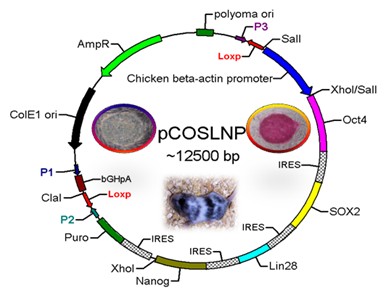| 多能干细胞作为一类具有无限自我更新和多向分化潜能的细胞群体,能够为未来细胞替换治疗提供无限的细胞来源。自1981年Martin J. Evans首次成功建立小鼠胚胎干细胞系以来,多能干细胞的研究蓬勃发展,到1998年James A. Thomson成功分离到人胚胎干细胞之后,与多能干细胞治疗相关的治疗开发、疾病模型、再生医学研究成为基础医学领域的前沿热点。尽管多能干细胞有望解决临床细胞替代治疗的细胞来源问题,但多能干细胞应用于再生医学仍面临着巨大的挑战,而克服移植免疫排斥是最关键的挑战之一。虽然ESC本身低表达或不表达主要组织相容性抗原复合物(major histocompatibility complex, MHC)分子,但随着细胞的分化成熟,MHC分子表达的类型及数量均增加,因此把ESC分化来的细胞用于临床细胞替代治疗时将不可避免同种异体的移植排斥问题。 2006年Yamanaka研究组建立的诱导多能干细胞技术是干细胞研究领域新的里程碑式的突破。同ESC相比,iPSC技术的运用,一方面能够避免破坏人类胚胎,从而避免hESC研究与应用的伦理道德上的争议;另一方面,由自体来源多能干细胞分化来的细胞应与自身的遗传背景(包括移植排斥最重要的MHC分子)一致,理论上可以避免移植排斥的发生。然而我们最近的工作表明小鼠iPSC来源的同源组织亦可以产生免疫原性。这一发现使得人们必须重新考虑基于多能干细胞技术的细胞替代治疗中的移植免疫排斥问题。 体细胞重编程本身是一个表观遗传基因组重塑的过程。尽管我们前期工作证明某些基因在iPSC分化过程中的异常表达会直接引起免疫排斥反应,然而重编程过程本身是如何在遗传及表观遗传学上诱导了这种异常还是远未回答的科学问题。另外,从应用上来讲,多能干细胞的临床开发还需要解决定向分化及免疫排斥的问题。如何建立基于多能干细胞技术的安全有效的免疫耐受方案及如何建立高效的定向分化策略是我们实验室感兴趣的研究方向。 
小鼠及人非整合iPSCs的建立
| 研究内容和目标:
研究组围绕多能干细胞的重编程、自我更新和发育分化等重要科学问题,运用分子生物学、生物化学、细胞生物学、遗传学和免疫学等手段,致力于开展多能干细胞的基础和临床应用研究。实验室研究方向主要集中于三个方面:1)干细胞临床开发的免疫学基础;2)细胞重编程的表观遗传学基础; 3)多能干细胞的定向分化。 代表性发表论文: - Zhou J#, Jin L, Wang F, Zhang Y, Liu B, Zhao T*. Chimeric antigen receptor T (CAR-T) cells expanded with IL-7/IL-15 mediate superior antitumor effects. Protein Cell. 2019,10(10):764-769.
- Gu H#, Shi X#, Liu C#, Wang W#, Shi N, Zhao Y, Gong J, Wang F, Zhang H, Li W*, Zhao T*. USP8 maintains embryonic stem cell stemness via deubiquitination of EPG5. Nature Communications, 2019, 10(1):1465.
- Wang L#, Ye X#, Zhao T*. The physiological roles of autophagy in the mammalian life cycle. Biological Reviews, 2019, 94(2): 503-516.
- Gong J#, Gu H#, Zhao L#, Wang L, Liu P, Wang F, Xu H, Zhao T*. Phosphorylation of ulk1 by ampk is essential for mouse embryonic stem cell self-renewal and pluripotency. Cell Death & Disease, 2018, 9(2): 38.
- Liu P#, Liu K#, Gu H, Wang W, Gong J, Zhu Y, Zhao Q, Cao J, Han C, Gao F, Chen Q, Li W, Jiao J, Hu B, Zhou Q, Zhao T*. High autophagic flux guards ESC identity through coordinating autophagy machinery gene program by FOXO1. Cell Death and Differentiation, 2017, 24(10): 1672-1680.
- Sun H#, Cao J#, Zhao L#, Zhu S, Chen S, Li Y, Zhao B, Zhao T*. PIM2 regulates stemness through phosphorylation of 4E-BP1. Science Bulletin, 2017, 62(10): 679-685. (Cover story).
- Liu K#, Zhao Q#, Liu P#, Cao J, Gong J, Wang C, Wang W, Li X, Sun H, Zhang C, Li Y, Jiang M, Zhu S, Sun Q, Jiao J, Hu B, Zhao X, Li W, Chen Q, Zhou Q*, Zhao T*. ATG3-dependent autophagy mediates mitochondrial homeostasis in pluripotency acquirement and maintenance. Autophagy, 2016, 12(11): 2000-2008.
- Zhu S, Cao J, Sun H, Liu K, Li Y, Zhao T*. p18 inhibits reprogramming through inactivation of Cdk4/6. Scientific Reports, 2016, 6: 31085.
- Zhang C, Cao J, Li X, Xu H, Wang W, Wang L, Zhao X, Li W, Jiao J, Hu B, Zhou Q*, Zhao T*. Treatment of multiple sclerosis by transplantation of neural stem cells derived from induced pluripotent stem cells. Science China Life Sciences, 2016, 59(9): 950-957.
- Zhao T#, Zhang Z#, Westenskow P#, Todorova D, Hu Z, Lin T, Rong Z, Kim J, He J, Wang M, Clegg D, Yang Y, Zhang K, Friedlander M, Xu Y*. Humanized mice reveal differential immunogenicity of cells derived from autologous induced pluripotent stem cells. Cell Stem Cell, 2015, 17(3): 353-359.
- Wang L#, Cao J#, Wang Y#, Lan T#, Liu L, Wang W, Jin N, Gong J, Zhang C, Teng F, Yan G, Li C, Li J, Wan H, Hu B, Li W, Zhao X, Qi Z*, Zhao T*, Zhou Q*. Immunogenicity and functional evaluation of iPSC-derived organs for transplantation. Cell Discovery, 2015, 1: 15015.
- Zhao T, Zhang Z, Rong Z, Xu Y*. Immunogenicity of induced pluripotent stem cells. Nature, 2011, 474(7350): 212-216.

|

